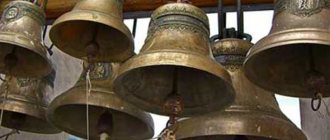The ringing of bells evokes joyful surprise in every person, regardless of whether he is a believer or not. The sound of the bells makes people, against their will, turn their eyes towards the temple and smile.
A bell tower with several melodious voices is the pride of every temple. The ringing of bells, which has healing powers for Orthodox souls, depending on the type, “calls” people to service, “sings” during celebrations and sounds like an alarm bell in case of danger.
When you hear the bell ringing, you need to cross yourself and pray
Types and names of bells
Among the ringing of church bells, the following types are distinguished:
- The ringing itself, which is divided into the following subtypes:
- trezvon consists of three strikes on all bells with short breaks. The trezvon symbolizes immense joy on major holidays;
- the two-ringing, accordingly, consists of two beats and means the transition from Vespers to Matins during the all-night service.
- chiming is alternate single strikes on each bell from largest to smallest. Repeated many times without interruption and embodies the Lord's exhaustion.
- busting (funeral ringing) - this, as with chiming, is one-by-one striking each bell, but from smaller to larger and with long breaks, and after each cycle of striking all bells are struck once. The call is made at the end of the funeral service, thus expressing grief.
- The trezvon is performed by the bell ringer in free form.
- Blagovest, announcing the beginning of the service, is performed independently or is included in the composition of other bells:
- Everyday news, which is used on ordinary days.
- Festive announcement.
- Alarm warning of impending disaster.
To carry out the above ringings, you need at least three bells, but the more there are, the richer and more beautiful the sound is.
Usually there are at least 5 bells in a belfry. Bells, like ringing, are divided into different types: ringing (trill), ringing and bass. They differ in weight and sound.
All about bell ringing: where to listen
The art of Russian bell ringing has centuries-old traditions. However, time, constantly making its changes throughout life, did not spare the bells. So, for example, instead of the unique, one-piece casting of bells in the 19th century, mass production came; already in the 21st century, “Electronic bell ringers” were increasingly installed on bell towers, and now the bells themselves are “sold” in mp3 recording format. But the ancient craft skills did not disappear without a trace. “St. Petersburg.ru” invites you to remember how it all began, where you can hear the best bell ringing in St. Petersburg, and understand why both believers and atheists stop when they hear the ringing of bells. Metal and spirituality
Bells, like trumpets and drums, came to us from ancient times, where they were an indispensable attribute of pagan cult. So in ancient Rome, a bell in the shape of a flower hung in front of the entrance to the temple of the goddess Cybele.
In Rus', church bells, as a rule, marked the start of the service and had a security function: the alarm announced fires, enemy attacks, and riots. Initially, there were very few bells in Russian churches. In those days, there was only one type of ringing - Blagovest; later, with the addition of more bells, Perezvon appears, which is an enumeration of bells, according to their weight, from larger to smaller and vice versa, as well as Bust and Trezvon. Gradually, with an increase in the bell scale and the weight of the bells, special structures began to be built for them - belfries and, from the 17th century, bell towers, which were located at the temple.
“The Russians loved bells so much that we learned to cast them from foreign masters. Craftsmen came to us with their technologies and their metal. It was a very expensive technology to cast a bell. The method of their manufacture was kept secret for a simple reason - at the same time, it was possible to learn the secret of casting guns. Later, when the “technologies” were mastered, differentiation occurred - different craftsmen cast bells and cannons,” Vladimir Kaychuk, the senior bell ringer at the Cathedral of the Vladimir Icon of the Mother of God, told about the history of the beginning of bell making in Rus'.
In Rus', guns are a symbol of strength. And the bell is a symbol of faith, spirituality, and strength. There was a time when bells were captured, taken captive, given as gifts, and after a won battle a temple or chapel with a bell tower was erected. The next prince tried to cast a larger bell than his predecessor did. There was one more important nuance: the sound of the bell was supposed to “cover” the Russian expanses, since the signaling system then worked precisely thanks to the ringing of the bells. This circumstance contributed to the gradual increase in the size of the bells. But the people of that time, and probably even modern people, could not build a device that could hold huge swinging bells. And the way they sound changed: “ochepny” (when the bell was rocked), was replaced by “tongue” ringing (they rocked the “tongue”).
“Russia is our bell empire and power, and especially Moscow. We have the largest bells in the world,” explains Vladimir Kaychuk.
Renovation or tradition?
The revolution and many years of persecution of the church in Russia led to the almost complete loss of bell-ringing traditions. I would like to immediately note that, due to the specifics of bell ringing, it is difficult to repeat it, but starting from the 19th century, ringings began to be recorded in notes. Thanks in part to this, the next generation was able to reproduce the overall sound pattern.
“We really don’t reproduce the bells exactly as they once were, but fortunately this is not required. In order to understand what kind of bells existed, say, in the pre-revolutionary period of Russian history, you can read numerous testimonies and descriptions reflected both in fiction and in historical documents of that time. A great source of information are also bell works that ended up in classical music, audio and video recordings preserved from the post-war years, and, of course, the traditions of churches and monasteries that did not stop working in Soviet times,” he told the St. Petersburg correspondent .ru" teacher, full-time cleric and bell ringer of the parish of the Nativity of the Prophet John the Baptist in the village of Yukki, head of the St. Petersburg Diocesan School of Bell Ringers, priest Pavel Radin.
In Russia, one of the traditional bearers of bell ringing is the Pskov-Pechersky Monastery; here, during times of church persecution, divine services did not stop, which means that knowledge accumulated over centuries was passed on. The tradition has been preserved in Rostov the Great, and there you can also see ancient bells that survived thanks to the efforts of Anatoly Vasilyevich Lunacharsky, who contributed to the issuance of a safe conduct for them, which made it possible for the unique ensemble of the belfry of Rostov the Great to avoid the fate of the majority of bell towers in revolutionary Russia.
Bell ringer Vladimir Stepanovich Kaychuk said that some traditions of bell ringing were partially recreated. In the 1960s, many researchers tried to restore and understand how Rus' and Russia used to sound, exactly what they sounded like, because all the cities stood in a chain of monasteries, temples, churches, and the ringing of bells was as familiar as the air or the coming spring. The tradition of Rostov the Great, for example, was reconstructed thanks to the filming of a film based on Leo Tolstoy’s novel “War and Peace” in the 1960s. “Director Sergei Bondarchuk, who was shooting the film, needed to reproduce the historical sounding background - bells. At that time, almost no one knew how to call correctly. The cry for Soviet cities brought “old men from Rostov” to Moscow, who as boys heard pre-revolutionary bell ringings, and they helped reconstruct it,” said the senior bell ringer.
There is another way to achieve the former musicality of Russian bell ringing - practice, improvisation and study. Ringers from Veliky Novgorod, Rostov-on-Don, Moscow and other Russian cities are re-birthing the art of bells, gathering at bell music festivals, where they exchange practical experience and study the bell-ringing styles of different regions. But not everything about bell ringing can be learned from a person. As bell-ringer and priest Pavel Radin said, any practicing bell-ringer knows that you learn bell ringing... from your own bell tower. It is the instrument that dictates to the bell-ringer what can be performed on it and what cannot.
Vladimir Kaychuk is confident that almost anyone can become a bell ringer
Improvisation on bells
In addition to church bells ringing, which announce the beginning of services and holidays, thanks to the efforts of virtuosos, such a thing as bell music appeared. Like any other musical instrument, bells are now used for improvisation, with composers and performers composing and "playing" bells outside of its canonical use.
Pavel Radin during the recording of bell ringings
After communicating with different bell ringers, the correspondents of St. Petersburg.ru realized that in bell music there are two types of bell ringers: bell ringers-musicians who perceive their bell towers as an instrument, as a space for creativity and experimentation, and guardians of traditions - they do not strive for individualizing their art, but serving people and God.
“There are no people without a gift. The Lord has endowed all people with his gifts, and each person is individual. And everyone has gifts that others do not have, says Vladimir Kaychuk. — Almost anyone can become a bell ringer, it is important what kind of “stuffing” a person has. Depending on how a person feels, this is how he will call - stiffness, irritation, harmony - everything is visible and audible.”
Ringers can talk about bells like they talk about children. To this day, some people maintain the ancient tradition of giving names to bells. Bells are like people, with their own voice and temperament. Like a child, a bell is “born” special. There is even a science about the study of bells - campanology. Treatment with bell music
“Ringing bells cures any disease, and bells destroy all harmful viruses, bacteria and microbes,” such information regularly appears on the Internet, and among its supporters there are many near-medical people. However, according to Father Pavel, such speculation has no basis. But there is a “physical” explanation why a person, anyone, is at least interested in listening to bell music.
“The whole point,” explains Father Pavel, “is that the “composition” of bell music is unique. The main feature of the sound of a bell is that when the “tongue” of the bell hits its edge, not one, but several sounds—overtones—appear at once. They are arranged in a strict order and are practically indistinguishable by ear, merging for us into a single note. However, the sound spectrum of a bell is a special combination of overtones, the ratio of which is individual for each of them. and whether we like it or not, the brain begins to try to solve this riddle, understand the picture, recognize the sound. He tries to arrange the overtones he hears in the sequence in which he learned to hear them and in the order that is convenient for him and seems logical. He searches and does not find, because the peculiarity of the sound spectrum of a bell is its inharmonious structure and, for this reason, the partial tones that our brain needs to obtain a full picture of the sound may simply not exist.” This work of the brain gives sensitive people a feeling of increased health.
Carillon of the bell tower of the Peter and Paul Cathedral
Vladimir Kaychuk
Pavel Radin
Bell towers you can't pass by
On the advice of the bell ringer of the Cathedral of the Vladimir Icon of the Mother of God Vladimir Kaychuk and the teacher, full-time cleric and bell ringer of the parish of the Nativity of the Prophet John the Baptist in the village of Yukki, the head of the St. Petersburg Diocesan school of bell ringers, priest Pavel Radin, we have compiled a list of bell towers where you can hear the best St. Petersburg bell ringings:
1. Peter and Paul Cathedral (Cathedral in the name of the supreme apostles Peter and Paul) Orthodox cathedral in St. Petersburg in the Peter and Paul Fortress, the tomb of the Russian emperors. The bell tower is still the tallest bell tower of the Russian Orthodox Church. Its height is 122.5 meters: a 40-meter gilded spire, a 60-meter stone structure and some superstructures. The bell ringing of the Peter and Paul Cathedral includes one of the heaviest surviving historical bells in St. Petersburg - the 5-ton blagovestnik. There is also a carillon on the bell tower. Peter and Paul Fortress, Hare Island
iskusstvu.ru
2. Holy Trinity Cathedral of the Alexander Nevsky Lavra is the cathedral church of the Alexander Nevsky Lavra in St. Petersburg. Construction of the cathedral began under Emperor Peter I. The cathedral was consecrated on August 30, 1790, at which time the relics of St. book Alexander Nevsky, in addition, a particle of the relics of St. Apostle Andrew the First-Called is buried in the cathedral. Embankment of the Monastyrka River, building 1
clubs.ya.ru
3. Spaso-Preobrazhensky Cathedral (Cathedral of the Transfiguration of the Lord of All Guards) is an Orthodox church of the St. Petersburg and Ladoga diocese of the Russian Orthodox Church. Built according to the design of V.P. Stasov in 1829 on the site of an earlier temple. A monument of classicism architecture. Never closed for worship; in the 1920s - 1940s, in certain periods it was under the jurisdiction of various “renovationist” structures. The names of Preobrazhenskaya Square (formerly Radishchev Square), on which it stands, and the nearby Radishchev Lane (formerly Tserkovny Lane) come from the Transfiguration Cathedral. Preobrazhenskaya Square, building 1
spbfoto.spb.ru
4. The Cathedral of the Vladimir Icon of the Mother of God is an active Orthodox church on Vladimir Square in St. Petersburg. Dedicated to the Vladimir Icon of the Mother of God, one of the most revered icons in Rus'. The names Vladimirsky Prospekt and Vladimirskaya Square come from the Vladimir Church. Bell ringings can be heard every day: 20 minutes before the start of morning and evening services. Saturday evening (from 18:00), Sunday (from 10:00), and on holidays. Vladimirsky prospect, 20
al-spbphoto.narod.ru
5. Church of the Savior Not Made by Hands, the building was originally built for other purposes. In 1736, in connection with the desire of the employees of the court stable yard to have their own temple, Empress Anna Ioannovna ordered the creation of a church here. It was then that the wooden Church of the Savior Not Made by Hands was built in the chamber above the gate, and later a stone one. In 1837, the funeral service for Alexander Sergeevich Pushkin was held in the church. After 1917, the temple was looted, in 1919 it was closed, the temple library was destroyed, and the bells were melted down. In 1923, the Mounted Police Club was opened here. The stable church was returned to believers in 1991. By 1999, restoration was carried out. Currently, every February 1st, a memorial service for A.S. Pushkin is held here. Konyushennaya Square, 1
ipetersburg.ru
6. Church of the Smolensk Icon of the Mother of God (Smolensk Church) is one of the oldest Orthodox churches in St. Petersburg. Located at the Smolensk cemetery. According to legend, St. took part in the construction of the church. Blessed Ksenia of Petersburg, who secretly carried bricks to scaffolding at night. Vasilievsky Island, Kamskaya St., 24
kuraev.ru
7. Cathedral of the Holy Apostle Andrew the First-Called (St. Andrew's Cathedral) is an active Orthodox cathedral on Vasilievsky Island in St. Petersburg, an architectural monument of the 18th century. In 1729, a new church in the name of the Holy Apostle Andrew the First-Called was founded on Vasilievsky Island, and in 1732, consecrated. In 1744, the church was given the status of a cathedral. Vasilyevsky Island, 6 line, building 11
fotki.yandex.ru
8. Temple of the Fedorov Icon of the Mother of God in honor of the 300th anniversary of the House of Romanov The temple is made in the style of the Rostov cathedral churches of the era of the accession of Mikhail Fedorovich. In 1907, to commemorate the approaching 300th anniversary of the House of Romanov, it was decided to build a cathedral in the capital. The foundation stone of the temple took place on August 5, 1911 in the presence of Grand Duke Mikhail Alexandrovich. The parish operated until 1932. The temple-monument was turned into a dairy factory and rebuilt, its domes were demolished. For 40 years, the church, completely redesigned inside, stood decapitated. In 1993, the city authorities transferred the Feodorovsky Church to the diocese. On March 27, 2011, the restoration of the bell tower was completed, onto which an exact copy of the 19th century bell ensemble was erected. You can hear the bells ringing 20 minutes before the start of the service. Mirgorodskaya street, 1
feosobor.ru
9. Church of the Nativity of John the Baptist in the village of Yukki is an Orthodox church, construction of which began in April 2009. As the church bell ringer Father Pavel said, despite the fact that all the bells are modern from factories in Moscow, Voronezh, Yaroslavl, the concept of authentic bells has been preserved there. Bells have always been collected over decades, and this situation can be imitated by collecting bells from different manufacturers. Currently, the Temple in Yucca is still being completed, but you can already hear the bell ringing. You can hear the bells ringing 20 minutes before the start of the service. Usually daily at 9:40 and 16:40.
fotki.yandex.ru
10. Church of the Annunciation of the Blessed Virgin Mary is an active Orthodox church. In 1994, the parish of the Annunciation Piskarevskaya Church was founded in the Bolsheokhtinsky deanery. The parish, which united people with disabilities of the musculoskeletal system and people helping them, conceived and began to implement the creation of a church complex on Piskarevsky Avenue in St. Petersburg. Currently, services are regularly held in the church, a Sunday school for children and adults operates, and a library of spiritual literature is open. Piskarevsky prospect, house 41
fotki.yandex.ru
11. Church of the Resurrection of Christ near the Warsaw Station (Church of the Resurrection of Christ of the All-Russian Alexander Nevsky Brotherhood of Temperance) is an active church in St. Petersburg, part of the Admiralty Deanery District. At the end of the 19th century, the area near the Warsaw and Baltic railway stations was the working outskirts of the capital. The St. Petersburg Society for Religious and Moral Education in the spirit of the Orthodox Church petitioned the city authorities to allocate a plot of land for the construction of a temple. The first wooden Church of the Resurrection of Christ was built in 1894. Obvodny Canal Embankment, building 116
al-spbphoto.narod.ru
12. Church of the Presentation of the Lord is an Orthodox church in St. Petersburg on the banks of the Murinsky stream at the corner of Grazhdansky Avenue and Lunacharsky Avenue. Rings for weekday services are made with one bell. All bells can be rung on any Sunday or all Twelfth Holidays from 9:45 to 10:00 and after the service (approximately around 12:00 for 10 minutes). Civil Avenue, building 101
al-spbphoto.narod.ru
13. Church of the Holy Apostle Peter in Vesyoly Poselok, the parish was registered only in 2005. The temple was designed in the New Russian style with complex multi-vaulted architecture. Iskrovsky Avenue, 11
al-spbphoto.narod.ru
Text: Marina Belyaeva Photo: Yuri Strofilov
Bell ringing to cleanse the house
You can cleanse your home of negativity, which manifests itself in the form of constant quarrels and scandals, various kinds of troubles, with the help of ringing bells using a sound recording. In this case, the recording should be clear, if possible without extraneous noise.
Before you begin to cleanse the space of your apartment with the ringing of church bells, you should do some cleaning. It is recommended to pray with lit candles while listening to such a recording. Ringing increases prayer power.
Not being able to attend services on major Orthodox holidays, you should turn on the ringing of bells at home on these days in order to neutralize the accumulated negative energy.
What is a sign if you hear church bells ringing in reality?
Bells have long been given great importance, because it was believed that their ringing drives out demons and demons. The quality of the sound itself, heard in reality, was also important:
- The ringing of a bell, ringing loudly, clearly, melodiously and carrying far away, foreshadows clear, windless and dry weather.
- A muffled and dull sound is heard on the eve of rain and bad weather.
Church chimes are also credited with healing and magical properties. It helps to get rid of health problems, remove the evil eye, damage and wash away all the accumulated negativity. With the help of bell alarms, epidemics of terrible diseases are driven away, witches are scared away from settlements, and even small pests (rodents, insects, etc.) are expelled from the fields.
For newlyweds whose wedding is accompanied by church bells, the sounds they hear guarantee a special protective and cleansing power, driving away all kinds of evil spirits and human ill will. Those who marry will have a long and happy life ahead. A chime that catches the newlyweds on the road warns of possible misunderstandings and difficulties in the family.
Attention! Sailors have their own superstition about this: the ship’s bell, suddenly suddenly coming to life and “speaking,” announces a ship that is at that moment being wrecked and its fellow shipmates perishing.
Treatment with bells
The healing effect of bell ringing has been proven by scientific research. The ultrasound generated with each bell strike promotes a speedy recovery for people suffering from infectious or inflammatory diseases.
Bell therapy is actively used in the treatment of cancer patients. Psychotherapists advise everyone who suffers from depression to systematically undergo bell therapy sessions.
The ringing of bells can relieve almost any pain. In practice, there are cases of relief in the condition of those possessed after exposure to the ringing of bells.
Whether it is grace or specific vibrations that affect a person this way, everyone decides for himself.
What is a sign if you hear church bells ringing?
Superstition is extremely negative when the ringing of bells is heard on an ordinary non-holiday day and is heard from nowhere, because there is no temple nearby. This is a very unkind sign, foreshadowing someone’s imminent death. It is especially bad to hear a church chime consisting of several “voices”. According to another version, a bell ringing heard from nowhere guarantees the fulfillment of any wish made at that moment.
Hearing the usual ringing of bells in front of you and to the right is a positive superstition, foreshadowing favorable news. But the sound coming from the left or behind does not promise anything good. Soon there may be forced troubles and disturbing news.
Important! An unknown bell ringing at night advises you to be careful and attentive to details in order to avoid impending misfortune (theft, fire, etc.). Hearing a bell ringing in the morning is a wonderful omen, promising an addition to the family.
Bells have always been considered sacred
Bell ringing, healing the soul and body from negativity
The power of bell ringing is that it simultaneously affects the soul and body of a person, freeing them from filth. It is noteworthy that the sound waves from the strike of the bell diverge in a cross.
This sound literally sterilizes the space, leaving no chance for germs and bacteria. In addition, church bells spread joy and tenderness among the people listening to them.
At least once a year, everyone needs to listen to the chimes performed live, because the recording is not able to fully convey the full power of energy emitted by the bells.
It is impossible to express in words how important and necessary the ringing of bells is, because it is what calls believers to unity in prayer.
What is the purpose of church bells
In the arrangement of a Christian church, every thing has its own purpose. The souls of Orthodox Christians, when listening to church overflows, are filled with light, joy, peace, and tranquility. When the bells sound like an alarm, Christians know that trouble has happened.
The Orthodox ringing is filled with amazing power, which has the ability to penetrate human hearts . In church sounds and overflows, Russian Orthodox people have learned to distinguish triumph, call and alarm, hearing a certain ringing.
An amazing phenomenon - when the bells sound, doves, prototypes of the Holy Spirit, do not fly away, but, on the contrary, rush to the churches.
Hearing the sound of the bells, the Orthodox people rush to the Divine Services, to which they are called by the rhythmic strikes of the bell. The sounds announcing the triumph of the Church and festive services fill the hearts of believers with joy and joy. Celebration and reverence cause chimes to ring during solemn services.
Where you can listen to the healing ringing of church bells
For healing, it is best to go to places of worship, such as monasteries. One of the most revered holy places is Optina Pustyn.
In Optina Hermitage there is a unique wooden belfry. Despite the fact that the belfry was desecrated by the murder of monks, pilgrims come here constantly in the hope of healing.
The Trinity-Sergius Lavra has the highest bell tower in Russia - 90 meters.
Fans of bell ringing and those simply wishing to experience its healing power can visit a number of themed festivals. “Ufalian Blagovest” will take place in Upper Ufaley, the All-Russian Bell Ringing Festival is held annually in Yelabuga, and “Crystal Bells” can be heard in Kargopol.
People believe in the special properties of bell ringing and turn to it for support, healing and purification, and see it as the personification of hope. The phenomenon of bell ringing is amazing and fascinating.
Alternative view
Bell ringing has long been considered not only a source of information about church services. Due to the merging of pagan and Christian consciousness, its true meaning was mixed with various beliefs, some of which are explained by logical arguments. What science says to a person who happened to hear a bell ringing, and what sign is hidden behind it, we will now talk.
—
What does the ringing of bells mean?
Previously, people, especially those living in rural areas, believed that he not only announced the beginning of a service or other church event, but also dispersed evil spirits. It was considered obligatory to turn towards the church and cross yourself when receiving the blessing. To do this, they took time off from any business.
Over time, signs were born:
- If the bells sound loud and clear, then the weather in the coming days will be good and the sky will be clear. If it’s deaf, it will soon start to rain. This sign has a scientific explanation: on the eve of rain, humidity in the air increases, it becomes thick and viscous, which affects the sound propagated.
- If the ringing of a bell is heard as if from nowhere, and there is no reason for it, then this is a harbinger of imminent death. They justified it this way: not far from the church there is a murderer, whose hands are already stained with blood, and he can repeat the crime. The alarm in this case is a reaction to a bad conscience, a fallen soul.
Among sailors, the sound of bells not related to service was considered a message about a wrecked ship, mourning for the dead.
Medical point of view
The ringing of church bells used to be considered healing: supposedly most diseases are the result of demons possessing a person, which can be expelled in this way. It happened that the ritual brought healing or at least relieved symptoms. Subsequently, doctors explained this by saying that the ringing of bells contains special vibrations that can have a positive effect on the immune system and weaken some bacteria.
Even people who are far from superstitions often freeze in awe when they hear solemn and pleasant sounds that can cause delight and, as a result, an increase in mood, which cannot but affect the general condition of the body.
At the same time, they can aggravate an alarming situation, especially if the weather is cloudy outside - in general, the picture turns out to be frightening, and therefore a person can become despondent, which is why everything will fall out of hand. Thus, signs about bells ringing can be not only superstitions, but also completely understandable patterns.
Natalia Illarionova











